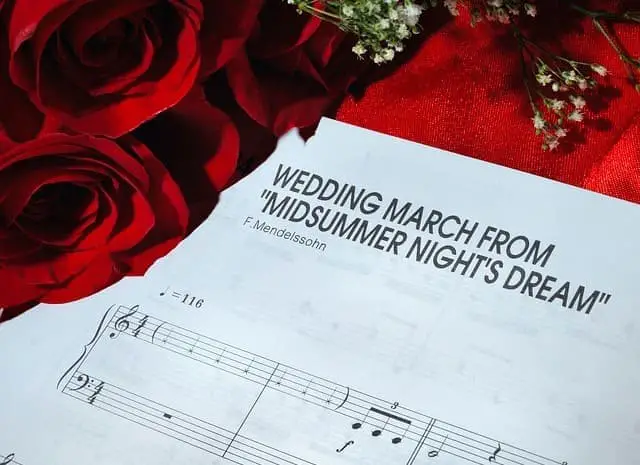- Home
- Basic Piano Theory
- Compound Meter
Compound Meter in Music
This article may contain compensated links. Please read the disclosure for more info.
Compound Meter is when the beats in a musical piece are subdivided into three smaller beats. The compound time signature is easy to recognize since it will have the numbers 6, 9, or 12 (numbers that can be divided by 3) on top.
Let's take a closer look, but first, we'll look at the musical meter. Then we'll learn the difference between a simple and a compound meter. And finally, we'll focus on the compound meter and its time signatures.
What is Musical Meter?
Musical meter is how the beats are organized in a piece of music. But the musical beats can be arranged on different levels.
First, the main beats of a piece form groups depending on where the stronger beats fall.
The most common groupings are in 2's, 3's, and 4's, called duple, triple, or quadruple meter.
Duple, Triple or Quadruple Meter
When we listen to a piece of music and focus on the beats (where we want to stamp our feet or clap along), we may notice that some beats are stronger than others. If we call the strongest beat 1, some common groupings are 1-2, 1-2-3, and 1-2-3-4. Like this:
- 2 main beats per group: "loud-soft-loud-soft" (Like a March). This is called Duple meter:
- 3 main beats per group: "loud-soft-soft" (Like a waltz). This is called Triple meter:
- 4 main beats per group: "loud-soft-soft-soft" (Most common). This is called Quadruple meter:
Is it Simple or Compound Meter?
Next, each main beat can also be felt as subdivided into either 2 smaller beats (1-and 2-and, etc.) or 3 smaller beats (1-and-and 2-and-and, etc.).
If the beat is subdivided into 2 smaller beats, it is called Simple Meter:
With the subdivision in 3 smaller beats, it is called Compound Meter:
Compound Time Signatures
The meter is written in the score as two numbers in the beginning of the staff. This is called a Time Signature.
The Compound time signatures are, as mentioned above, easy to spot. They have the numbers 6, 9, or 12 on top. Some commonly used are:

- The top number tells us the number of beats per measure.
- The bottom number tells us what note value is worth 1 beat.
It can be any note value, really, but the most common here are 4 (=quarter note), 8 (=eight note), or 16 (=sixteenth note).
Compared to Simple Time Signatures (where we have to imagine the subdivision of the beat in 2's to be sure it is not compound), Compound Time Signatures show all the "smaller" beats (as the bottom number).
But we must still group the beats in 3's to understand if it is in Duple, Triple or Quadruple time. The main beats in compound time could also be seen as dotted note values:

Compound Duple
What's interesting is that the beats are grouped in 3's. So in time signatures with 6 on top, the beats are grouped 3 + 3. But since it is two groups, this is Duple meter or, in this case more specifically, Compound Duple.
Some famous pieces in 6/8:
- R. Schumann: The Wild Horseman
- Grieg: Morning from Peer Gynt
- Delibes: The Flower Duet from Lakme
Compound Triple
Time signatures with 9 on top are in triple time (3+3+3):
Some famous pieces in 9/8:
- Beethoven: Piano Sonata Op. 79: Andante
- J.S. Bach: Jesu, Joy Of Man's Desiring (is also written in 3/4 but in triplets)
- Debussy: Clair de Lune
Compound Quadruple
And time signatures with 12 on top are in quadruple time.(3+3+3+3)
Some famous pieces in 12/8:
- Chopin: Nocturne op 9 no 2
- Memory from Cats
- Mozart: Lacrimosa from the Requiem
Recommended Resources
- How to Read Music in 30 Days: Music Theory for Beginners
- Sight Reading and Rhythm Every Day
- Learning to Read Music
- Alfred's Essential Music Theory





